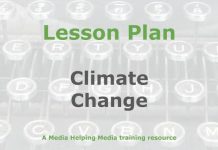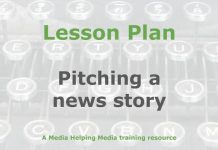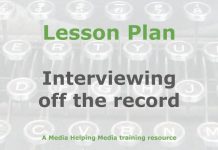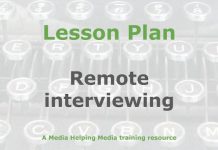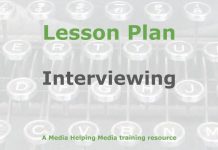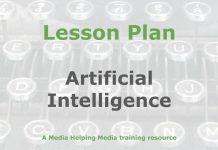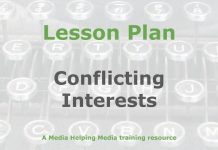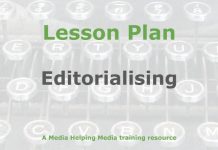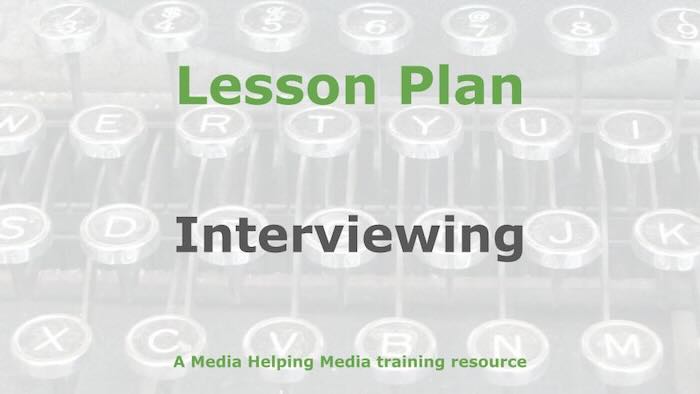 This lesson plan is designed to teach students how to carry out an interview in a way that reveals new and important information.
This lesson plan is designed to teach students how to carry out an interview in a way that reveals new and important information.
It’s based on the article ‘Preparing for and carrying out an interview‘ which is published on Media Helping Media. We recommend you read the article before adapting the lesson plan below.
Learning objective
Students will formulate and ask at least three concise, relevant questions during an interview, demonstrating active listening and adaptability based on the interviewee’s responses. They will also evaluate the effectiveness of their questions in obtaining informative answers.
- Student-facing objective: By the end of this lesson a student will be able to create and ask at least three focused questions in an interview. They will learn how to listen carefully to the answers and then assess how well their questions worked.
- Standards: Journalists will learn some of the techniques required for carrying out an informative interview.
Learning activities
Warm-up
- Begin with a brief discussion on the importance of asking effective questions. Pose the question: “What makes a question effective in an interview?” Allow students to share their thoughts.
- Next, introduce a quick activity: “Question Refinement.” Present a vague question related to a familiar topic, such as “What do you do?” Ask students to refine it into a more specific and informative question, like “What inspired you to pursue your current career?”
- Encourage students to think about clarity, relevance, and the potential for eliciting detailed responses. Have a few students share their refined questions and discuss why they are more effective. This primes students for the lesson’s focus on crafting concise, relevant questions.
Direct instruction
- Conceptual understanding: Explain the importance of preparation in interviewing. Discuss how thorough research helps in formulating effective questions. Use a real-world example: a journalist interviewing a local business owner. Highlight how understanding the business’s background can lead to more insightful questions. Emphasise the need to focus on three key questions to maintain clarity and depth.
- Procedural skills and fluency: Demonstrate how to construct concise questions. Use the six basic question types: what, why, when, how, where, and who. Provide examples of each type related to the business owner interview. For instance, “What challenges have you faced in the past year?” Guide students to practice creating their own questions, ensuring they are direct and relevant.
- Application: Illustrate active listening techniques. Role-play a short interview with a student, focusing on maintaining eye contact and responding to the interviewee’s answers. Show how to adapt follow-up questions based on responses. Discuss the importance of not relying on notes and being present in the conversation. Encourage students to think about how these skills apply to their own interviews.
Guided practice
Think, Pair, Share: Guide students through a structured interview practice.
- Think: Have students individually draft three concise questions for a mock interview with a classmate. Encourage them to focus on clarity and relevance, using the six basic question types.
- Pair: Pair students and have them take turns interviewing each other using their drafted questions. Remind them to practice active listening, maintain eye contact, and adapt follow-up questions based on responses.
- Share: After the interviews, bring the class together. Ask pairs to share one question they found particularly effective and explain why. Discuss how active listening influenced their follow-up questions.
- Reflect: Facilitate a brief class discussion on the challenges faced during the interviews and strategies used to overcome them. Encourage students to consider how they might improve their questions or listening skills.
- Feedback: Provide constructive feedback on their questioning techniques and listening skills, highlighting strengths and areas for improvement.
Independent practice
- Exercise: Assign students to conduct a brief interview with a family member or friend outside of class. They should prepare three concise questions, focusing on clarity and relevance. Encourage them to practice active listening and adapt follow-up questions based on the interviewee’s responses.
- Reflection: Have students write a short reflection on their experience. They should evaluate the effectiveness of their questions and describe any challenges they faced in maintaining active listening.
- Submission: Direct students to submit their reflections and a summary of the interview responses. Provide a placeholder for the submission link.
Circulate to observe and support students as they work on their reflections.
Assignment
Ask students to answer these questions:
- What is one main element of an effective interview question?
- How did active listening impact your ability to ask follow-up questions?
- What’s one question you still have from today’s lesson?
Here are some suggested answers:
- Suggested answer to Question 1: Clarity and relevance to the interviewee’s context.
- Suggested answer to Question 2: It allowed me to adapt my questions based on the interviewee’s responses.
Teacher resources
Differentiation guide
- Advanced learners: Encourage them to explore deeper, more complex topics during interviews. Suggest they prepare additional questions that probe underlying issues or motivations. Challenge them to conduct interviews with professionals in fields of interest, analysing the nuances of responses.
- Striving learners: Simplify the task by focusing on one or two key questions. Provide sentence starters or question templates to guide their formulation. Pair them with peers for additional support during practice interviews, ensuring they have opportunities to observe and learn from others.
- Recommended reading: This lesson plan is based on the article ‘Preparing for and carrying out an interview‘ which we recommend you read the article before adapting this lesson plan.
Notable definitions
- Interviewee: The person being interviewed, providing information or insights during the interview process.
- Active listening: A communication technique that involves fully concentrating, understanding, responding, and remembering what the interviewee is saying.
- Follow-up question: A question asked in response to an interviewee’s answer, aimed at gaining more information or clarification.
Required materials
- Notebooks: For students to draft questions and take notes.
- Pens/pencils: For writing and note-taking.
- Recording device: Optional, for students to record interviews for review.
- Timer: To manage time during practice interviews.
- Reflection worksheet: For students to evaluate their interview experience.
Lesson summary
- Warm-up
- Direct instruction
- Guided practice
- Independent practice
- Assignment
The free AI teaching tools at the Khan Academy were used in the production of this lesson plan.
Related article
